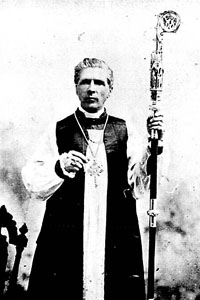T. B. Fuller
Early Years
On Niagara Becoming
an Anglican Diocese
T. B. Fuller Becomes
First Bishop of Niagara
Rev. Robert Addison
(1754-1829)
Rev. Charles Hamilton
2nd Bishop of Niagara
John Philip DuMoulin
3rd Bishop of Niagara
Clergy in the
Diocese of Niagara
in the 19th Century


 Written in 1892.
Written in 1892.
At a meeting of the Synod held in the School-house of Christ Church Cathedral, Hamilton, on the 27th of January, 1885, the Rev. Charles Hamilton, D.D., Rector of St. Matthew's Church, Quebec, and for some time Prolocutor of the Provincial Synod of Canada, was chosen to fill the vacant See. He was consecrated at Fredericton by the Metropolitan of Canada, assisted by the Bishops of Nova Scotia, Quebec, Maine, Toronto, and the coadjutor of Fredericton, on the 1st May of the same year, and at once entered upon his duties.
Bishop Hamilton is a Canadian by birth, but is, like his predecessor, of Irish extraction. He was educated at University College, Oxford, and graduated in that University in the year 1856. He was ordained both Deacon and Priest by Bishop George J. Mountain, and soon proved himself to be a diligent, wise, and successful parish priest. He is a man of dignified and winning manners, humble-minded, devout and energetic. He is credited with unusual practical judgment, and certainly is filled with fervent zeal for the advancement of the Kingdom of Christ.
The Diocese, though lately constituted, is not new territory, and is not therefore likely to expand with the rapidity of Huron and Ontario. Its growth can only be by subdivision of existing parishes and missions, and by occupying territory that was long neglected. Growth under such circumstances will necessarily be slow, as the neglected territory has long since been occupied by more than one of the denominations, and generally all the more religiously disposed and earnest souls have been gathered into one or other of these, only the careless ones, for the most part, being left as even nominal adherents of the Church of England.
When the Diocese was constituted there were forty-six parishes and fifty-one licensed clergymen within its bounds; since then fourteen new parishes have been constituted, and the clerical staff has been increased by seventeen. During this period twenty-five new churches have been built, many of which were consecrated at the time of opening, while many others have been enlarged and improved. There are now over forty parsonages, many of which have been built since the establishment of the Diocese. Hamilton, the See city of the Diocese, has manifested a great revival of Church life and activity. This life has shown itself in the establishment of five new parishes and four new churches. The Church throughout the Diocese has increased at least proportionately in strength. In 1875 there were only twenty parishes in the Diocese which did not look to the Mission Fund for assistance, now there are forty-two, and twenty-five new stations have been opened for public worship. Over 18,000 persons have been received into the Church by baptism, among whom were many adults, and a large number of these had been brought up outside the Church. About 12,000 persons have been confirmed; the average number for the last four years had been about 1000, a great increase upon the earlier years of Diocesan life. And it is worthy of note, that at least twenty-five per cent, of those confirmed were converts from the various denominations. It is also estimated that the number of communicants has more than doubled during the sixteen years of separate Diocesan life.
The Church's ministrations are being gradually and steadily extended into the hitherto neglected places of the Diocese. The interest in missionary work and the contributions for the support of the same are steadily increasing, while the sums annually raised for the maintenance of the clergy, the erection of new churches, parsonages, and other Church objects, are year by year becoming larger. In addition to these outward manifestations of revived life, there are other tokens of progress which are more reliable and more gratifying. There are larger congregations, more frequent and more reverent attendance at Holy Communion, larger numbers and more carefully prepared candidates for confirmation, and as a consequence a more intelligent and instructed Churchmanship spreading throughout the Diocese. It is probable that if the clerical staff could be increased by twenty-five or thirty additional members, the Diocese would be fairly well supplied, and the ministrations of the Church brought within reasonable reach of all the inhabitants. It is not too much to expect that, under the earnest and energetic administration of the present Bishop this result may be attained, and steady progress, and at least a gradual recovery of those who through neglect have left the fold, may be looked for.
John Philip DuMoulin, Third Bishop of Niagara
from History of the Church in Eastern Canada and Newfoundland by John Langtry, M.A., D.C.L., Rector of S. Luke's, Toronto, and Prolocutor of the Provincial Synod of Canada. London, Brighton and New York: Society for Promoting Christian Knowledge, 1892.
4 years after this account, on the 18th March 1896 Bishop Hamilton was elected Bishop of the newly created Diocese of Ottawa.
